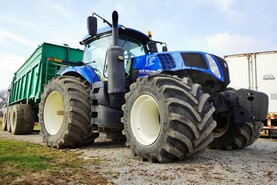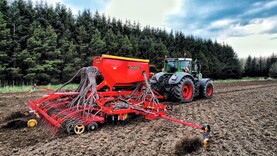As silage ground rejoins the grazing rotation in August, there is an opportunity to take out old and underperforming grazing swards for reseeding in the coming weeks.
While the window of opportunity is shorter compared with spring reseeding, August and early September is a good time to lay down new grass.
However, the key to a successful autumn reseed is timing. Weather permitting, the earlier the task is carried out, the better.
Getting grass seed in at the earliest opportunity means there is greater cover established before winter sets in.
There is also a greater chance of applying a post-emergence spray for weed control in autumn, as well as possibly taking a light grazing to encourage tillering. Outlined are some question farmers commonly ask before carrying out autumn reseeding.
1 How late can I leave reseeding?
For farmers considering an autumn reseed, when is it too late for sowing grass seed?
As days get shorter and nights get colder, the later you leave reseeding, the slower it will be to establish.
Ideally, in the northern half of the country, grass seed should be in the ground by the second week of September most years. Therefore, target a cut-off date around 10-12 September. In the southern half of the country, this could be pushed back to the third week of the month, with a target cut-off around 20 September.
Sowing after this time reduces the chances of getting ground cover established before winter.
Use the target dates to work backwards and plan out when burning off old swards, ploughing and tilling needs to be completed.
2 How long should I wait after burning off an old sward?
Burning off an old sward before reseeding is recommended, as it cuts down weeds coming through in the new grass.
Once sprayed, leave the sward for at least 10 days before ploughing. If there is a heavy infestation of docks in the sward, leave for 14 days before ploughing.
Docks have a deep root system and take longer to kill. Waiting the extra days will ensure the chemicals give more effective control.
3 Is ploughing the best option for reseeding?
If the field has compaction or drainage problems, then ploughing is recommended to alleviate these issues.
Ploughing will open soils for aeration and remove surface water. Provided existing drains are maintained and cleaned annually, there is little need to add further drainage.
A downside with ploughing is that it leaves a soft seedbed. This limits what stock can graze a new reseed in autumn, or early spring.
Rolling the ground after sowing grass, especially if broadcasting grass seed, will help to tighten the seedbed and improve soil contact.
When ploughing, it may take a few extra days for soil to dry out before it can be tilled. This will delay sowing grass seed, thereby shortening the window for reseeding.
4 What are the advantages of direct drilling into an old sward?
Direct drilling into a burned-off sward can be a good alternative for soils with no drainage issues. A big advantage is that the seedbed is firmer after the new sward is established compared to ploughing.
Also, as the soil is not disturbed, there are fewer problems with weeds coming through in the reseed.
However, as the old grass decays, it makes the seedbed acidic. Therefore, applying lime before reseeding is advisable to improve germination.
When direct drilling, it is important to graze the reseed with a ‘quick and often’ approach, using light stock like weanlings or sheep. This keeps the older grasses from re-growing and smothering the new grass seedlings.
5 Should I take soil samples before reseeding?
Normally the advice would be to take a soil sample before reseeding. However, when reseeding in August, a soil test is not practical.
Swards grazed and fertilised over the summer will give false readings for P and K. It is better to wait until January or February before soil testing, for a true reflection of soil fertility.
That said, if reseeding in autumn, applying lime, phosphate (P) and potash (K) is recommended to get seeds germinated.
6 Is a post-emergence spray needed?
Targeting a cut-off date by mid-September for autumn reseeds should give enough time to get a post-emergence spray applied in October. With autumn reseeding, weeds are less of an issue compared to a spring reseed. This means it should be easier to get on top of chickweed, red shank and docks. Weeds compete with new grass for soil nutrients, so spraying will increase the chance of successful autumn reseed.
7 Should I try and graze the reseed or will livestock damage it?
Ideally, you should aim to graze the reseed before closing for winter. This will help new grass to tiller out.
Sheep or weaned calves are more suitable for grazing reseeds, as they are lighter and will inflict less damage.
Graze using a quick and often approach, meaning graze for two to three days and then rest.
8 When is it safe to graze a reseed?
A quick test to determine if a reseed is ready for grazing is to grab a few plants between the thumb and index finger and pull with medium pressure.
If the seedlings are pulled up from the soil, the sward is not ready to graze.
If the seedlings remain in the soil, the sward can be grazed.
Target the second week of September as a cut-off point for sowing grass seed.When burning off old swards, allow at least 10 days before ploughing.Apply lime, P and K to the seedbed.Apply a post-emergence spray to control weeds.Graze hard and fast, then allow the reseed to rest.Take soil samples in February and draw up a fertiliser plan. Read more
Way Out West: a small breed offering big opportunities
€10m June injection for milk suppliers
As silage ground rejoins the grazing rotation in August, there is an opportunity to take out old and underperforming grazing swards for reseeding in the coming weeks.
While the window of opportunity is shorter compared with spring reseeding, August and early September is a good time to lay down new grass.
However, the key to a successful autumn reseed is timing. Weather permitting, the earlier the task is carried out, the better.
Getting grass seed in at the earliest opportunity means there is greater cover established before winter sets in.
There is also a greater chance of applying a post-emergence spray for weed control in autumn, as well as possibly taking a light grazing to encourage tillering. Outlined are some question farmers commonly ask before carrying out autumn reseeding.
1 How late can I leave reseeding?
For farmers considering an autumn reseed, when is it too late for sowing grass seed?
As days get shorter and nights get colder, the later you leave reseeding, the slower it will be to establish.
Ideally, in the northern half of the country, grass seed should be in the ground by the second week of September most years. Therefore, target a cut-off date around 10-12 September. In the southern half of the country, this could be pushed back to the third week of the month, with a target cut-off around 20 September.
Sowing after this time reduces the chances of getting ground cover established before winter.
Use the target dates to work backwards and plan out when burning off old swards, ploughing and tilling needs to be completed.
2 How long should I wait after burning off an old sward?
Burning off an old sward before reseeding is recommended, as it cuts down weeds coming through in the new grass.
Once sprayed, leave the sward for at least 10 days before ploughing. If there is a heavy infestation of docks in the sward, leave for 14 days before ploughing.
Docks have a deep root system and take longer to kill. Waiting the extra days will ensure the chemicals give more effective control.
3 Is ploughing the best option for reseeding?
If the field has compaction or drainage problems, then ploughing is recommended to alleviate these issues.
Ploughing will open soils for aeration and remove surface water. Provided existing drains are maintained and cleaned annually, there is little need to add further drainage.
A downside with ploughing is that it leaves a soft seedbed. This limits what stock can graze a new reseed in autumn, or early spring.
Rolling the ground after sowing grass, especially if broadcasting grass seed, will help to tighten the seedbed and improve soil contact.
When ploughing, it may take a few extra days for soil to dry out before it can be tilled. This will delay sowing grass seed, thereby shortening the window for reseeding.
4 What are the advantages of direct drilling into an old sward?
Direct drilling into a burned-off sward can be a good alternative for soils with no drainage issues. A big advantage is that the seedbed is firmer after the new sward is established compared to ploughing.
Also, as the soil is not disturbed, there are fewer problems with weeds coming through in the reseed.
However, as the old grass decays, it makes the seedbed acidic. Therefore, applying lime before reseeding is advisable to improve germination.
When direct drilling, it is important to graze the reseed with a ‘quick and often’ approach, using light stock like weanlings or sheep. This keeps the older grasses from re-growing and smothering the new grass seedlings.
5 Should I take soil samples before reseeding?
Normally the advice would be to take a soil sample before reseeding. However, when reseeding in August, a soil test is not practical.
Swards grazed and fertilised over the summer will give false readings for P and K. It is better to wait until January or February before soil testing, for a true reflection of soil fertility.
That said, if reseeding in autumn, applying lime, phosphate (P) and potash (K) is recommended to get seeds germinated.
6 Is a post-emergence spray needed?
Targeting a cut-off date by mid-September for autumn reseeds should give enough time to get a post-emergence spray applied in October. With autumn reseeding, weeds are less of an issue compared to a spring reseed. This means it should be easier to get on top of chickweed, red shank and docks. Weeds compete with new grass for soil nutrients, so spraying will increase the chance of successful autumn reseed.
7 Should I try and graze the reseed or will livestock damage it?
Ideally, you should aim to graze the reseed before closing for winter. This will help new grass to tiller out.
Sheep or weaned calves are more suitable for grazing reseeds, as they are lighter and will inflict less damage.
Graze using a quick and often approach, meaning graze for two to three days and then rest.
8 When is it safe to graze a reseed?
A quick test to determine if a reseed is ready for grazing is to grab a few plants between the thumb and index finger and pull with medium pressure.
If the seedlings are pulled up from the soil, the sward is not ready to graze.
If the seedlings remain in the soil, the sward can be grazed.
Target the second week of September as a cut-off point for sowing grass seed.When burning off old swards, allow at least 10 days before ploughing.Apply lime, P and K to the seedbed.Apply a post-emergence spray to control weeds.Graze hard and fast, then allow the reseed to rest.Take soil samples in February and draw up a fertiliser plan. Read more
Way Out West: a small breed offering big opportunities
€10m June injection for milk suppliers






 This is a subscriber-only article
This is a subscriber-only article









SHARING OPTIONS: